Archive for the ‘pet rescue’ Category
Cuteness Overload: Tortoise waering Wool Cozies Knitted Costume
Wednesday, July 23rd, 2014When disaster strikes, pet owners can turn to social media help find lost pets
Wednesday, April 11th, 2012Recently there was news about a 7+ earthquake in Indonesia. Thankfully there was no real damage as a result of that quake unlike the one that ravaged the area a bit over a year ago. While there is no good way to predict where a natural disaster is going to strike (and we have had our fair share in recent times) it is good to have a plan on recovering from one.
Today I came across an article on using social media after a disaster to help find lost pets. There were some good tips that I thought I’d share with you:
The first thing is to have accounts set up on social sites such as Facebook and Twitter. The reason is, if you need to get word out quickly, you’ll need to have friends and followers to get the word out to.
Next you will need to have pictures of your pets and have them posted on your facebook or Flickr, somewhere you can grab them that is apart from your home which may have been affected by the disaster.
And the third thing is to get the word out on your missing pet through social media avenues as soon as possible. The longer you wait to ask for help in finding a missing pet, the bigger the chance something can happen to your pet.
In the article there were three heart warming stories, each with a happy ending, after the pet owner lost a pet and then found it again using social media.
Powerful stuff.
Here is the link for the article:
http://www.suntimes.com/news/nation/11773185-418/after-disasters-social-media-help-find-lost-pets.html
This open letter from a rescue shelter to their local county animal shelter is a MUST READ
Wednesday, December 29th, 2010Here is a reprint of an open letter from PetLuv, a Florida non-profit spay and neuter clinic to the Hernando County Animal Services announcing they are severing ties with the shelter and exactly why. It is a must read….
Published: December 29, 2010
Updated: 12/28/2010 06:04 pm
This is a letter addressed to Liana Teague, manager, code Enforcement & Animal Services.
If it isn’t already obvious, this is official notification the PetLuv is severing its relationship with Animal Services. Over the years we have made many offers of programs, manpower, resource, and materials to try to help you reduce your euthanasia rate and increase adoptions. Most of them have been rebuffed or ignored, no improvements have been made, and too many animals continue to die. The reasons you have given for not accepting these offers have been “we don’t have the manpower or the resources,” “my bosses won’t buy it,” or “my staff wouldn’t accept it.” The offers we made were always at no additional effort or cost on your part. And in retrospect, I don’t think you ever made your bosses or your staff aware of most of the opportunities you were being handed.
To that end, I am listing just a few of the things I proposed to you beginning with our September meeting:
Manpower. I was told that a big hurdle to increasing adoptions was a lack of clerical staff to make spay and neuter appointments and process adoptions. I offered for PetLuv to provide and pay for a permanent, part-time position for the express purpose of handling those paperwork tasks. I also said we would consider hiring a recently-laid-off Animal Services employee, to provide experience and continuity.
One of PetLuv’s veterinarians, in addition to being a shelter veterinarian, does veterinary consulting. PetLuv will pay her fee to provide a professional assessment of changes could be made to increase adoption rates and decrease euthanasia.
PetLuv will pay for veterinarians to come to Animal Services as required to assess animals’ physical issues and their adoptability. (Three of PetLuv’s veterinarians have years of shelter experience, as does Doctor Figarola.)
PetLuv will treat or pay for treatment for adoptable animals with medical conditions that would otherwise be put down.
PetLuv will reduce the charges for spaying and neutering Animal Services animals by half. Adoptable animals would be altered upon entry, thus allowing more animals to be adopted instead of put down.
In return for this significant commitment of money in order to save more animals’ lives, I wanted to see the following: that no animal that has been altered in preparation for adoption will subsequently be euthanized; that at a minimum, 50 percent of available cages at Animal Services will be filled with animals for adoption at all times; that the adoption fee for Animal Services animals will remain at its current rate.
I don’t know why you didn’t jump at these opportunities, but I heard nothing from you for months. I had to push for another meeting on Dec 3. At that meeting you told me that your spay and neuter budget was depleted, at which time I made another offer: PetLuv would provide all food for Animal Services, allowing you to divert your food budget to spays and neuters. And effective immediately, PetLuv would cut your spay and neuter charges by half, and provide rabies shots free.
I doubt the “powers that be” prevented you from accepting these offers. And I doubt that your staff expressed resistance to these no-cost changes that would save more animals. As I said, I believe these proposals started and died with you, as did so many others in the past.
We can no longer work with and enable an organization that rejects or ignores no-cost offers to save more animals. So all of these offers are now off the table, including the one allowing you to divert your food budget towards spaying and neutering.
PetLuv will still alter and vaccinate animals belonging to owners adopting from Animal Services.
That includes the remaining Shih Tzus that need surgery. But they will be given regular appointments after they have been adopted, and after they have been out of the shelter for a minimum of 14 days. And they will be charged our regular surgery rates. This policy will apply to ALL dogs coming from Animal Services: we will accept them, whether for shots or surgery, after they have been in their owners’ homes for 14 days and free of symptoms. This is a permanent policy, necessitated by your failure to notify us of your last parvo outbreak and continuing to send animals over directly from an infected shelter, putting all of our clients’ animals at risk. But that’s another story…
In closing, I want to make clear that this decision to alter our relationship with Animal Services is not a reflection on the staff. I have known many of your personnel for years, and I know you have dedicated and caring people. But in the absence of a manager that is willing to work to save more animals rather than paying lip service, and in the absence of a manager that creates and enforces clear guidelines, protocols, and procedures, the staff is left to flounder the best they can, with decisions being made on an ad hoc basis.
PetLuv will never turn its back on any animal, no matter where it comes from. But we can no longer continue the relationship with Animal Srvices the way it currently exists.
Richard L. Silvani
Executive Director
PetLuv Nonprofit Spay and Neuter Clinic
——
In a time when animals are being abandoned at record rates and shelters are unnecessarily euthanizing pets because of overcrowding and lack of funds, this letter is disturbing to me to the extreme.
What do you think?

October is fire safety month. We have a plan for you and your pets!
Thursday, September 30th, 2010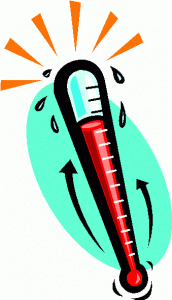 My sister called me today to tell me it was 111 degrees in Long Beach California. 111! Oh, right. It’s Indian summer right now – it happens every year – and the temperatures hover in obscene ranges as the dry Santa Ana winds punish region. Often these dry winds are accompanied by California fires (in fact, I just stumbled across a website that lists all fires in California. http://cdfdata.fire.ca.gov/incidents/incidents_current )- there were 12 major fires just this month!
My sister called me today to tell me it was 111 degrees in Long Beach California. 111! Oh, right. It’s Indian summer right now – it happens every year – and the temperatures hover in obscene ranges as the dry Santa Ana winds punish region. Often these dry winds are accompanied by California fires (in fact, I just stumbled across a website that lists all fires in California. http://cdfdata.fire.ca.gov/incidents/incidents_current )- there were 12 major fires just this month!
But no matter where you live, having safety precautions in place in the event of a fire is important.
Recently I wrote about pet fire safety for you and your pets called, oddly enough, Fire Safety for Your Pets. If you missed reading it, now is a good time to review- it being fire safety month and all…. The article discusses things you can do to make you and your pets safer in the event of a fire. There is also a link to ADT’s website where, in exchange for your name and address, they will send you a free window decal indicating pets are inside. These decals are good to have in the event of any emergency where your home is evacuated. Rescuers will know to check for pets in the event you are not home when the evacuation occurs. Your pet’s lives just might be saved because of that decal.
Here is the link to get a free decal for yourself: http://www.adt.com
The second part of your plan should be to have an evacuation plan in place. I mentioned California – land of earthquakes and wildfires. Well now I’m in Florida land of hurricanes.
As a result of living here, we’ve written several articles on hurricane evacuation plans, and those plans work just as well when planning an evacuation for any type of disaster be it hurricane, earthquake, tornado, flood, fire, etc. You’ll want to have some things handy in the event you have to vacate suddenly and the time to put them together is before you need them.
Here are a couple of articles that you can use as guidelines for putting together your own plan:
- Hurricane Evacuation Plan for Pets
- Evacuation Planning for your pets
- VetLocator’s Emergency Pet Help page
- Pet First Aid Kit
Pet First Aid Kit : It is always best to be prepared for emergencies and this applies to your pet’s health as well as to your own. A good suggestion is to have a Pet First Aid Kit handy located near your own First Aid Kit. We’ve put together a suggestion for what your kit should contain with our Pet First Aid Kit Checklist:
- A card with your veterinarian’s phone number and the location of the closest emergency pet hospital and the poison hotline (you can find information for both all of these at www.vetlocator.com)
- A roll of gauze to cover wounds. Gauze can also be used to wrap around the muzzle or beak of a wounded animal to keep them from biting.
- Non-stick gauze pads for wounds
- Towels for clean-up, covering the animal while moving or to keep warm.
- Adhesive tape for bandages
- 3% hydrogen peroxide for cleaning wounds
- Eyedropper for giving medicine orally (a syringe without the needle works well too)
- Saline solution to flush out debris in the eyes
- A couple of pairs of disposable rubber gloves
- Tweezers
- Soap
- Some extra food and treats
- Leash or rope
- Pet CPR reference from www.vetlocator.com
You should call your veterinarian as soon as you can to get advice on what to do in the emergency your pet is going through. If you suspect that your pet has been poisoned, let your veterinarian know, or call the poison hotline immediately. You will be given instructions on how to proceed in the quickest way to help your pet.
Remember, it is important not to panic. If you suspect poison, time is critical so telephone someone right away. www.vetlocator.com has many resources available for maintaining the health of your pet in our resource library, www.vetlocator.com/library.php.
Editor – Daily Paws
Home hospice and euthanasia for our pets
Thursday, April 22nd, 2010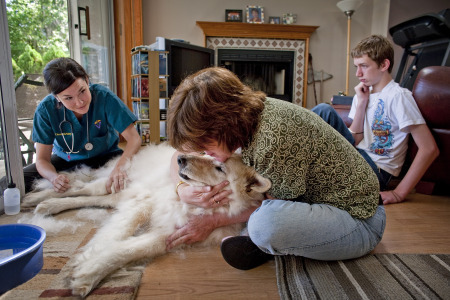
There is a growing trend in veterinary care – home hospice and home euthanasia for pets, and I, for one, am happy to see these services being offered on an increasing basis. Today there was an article in our local paper about one such veterinarian in the Tampa Bay area that gives a glimpse into a ‘day in the life of a home hospice/euthanasia veterinarian’:
From the Saint Pete Times – April 19, 2010
By Alexandra Zayas, Times Staff Writer
An hour before, Dr. Dani McVety begins to prepare. “Come on, girls,” she calls to her two rat terriers, “in the crate. “You too, Foose.” A big, brown mutt settles into the third cage in McVety’s Lutz home as she shuts the door and heads out to the garage. She pulls a green scrub shirt over her head, opens her trunk and unlocks a black box to reveal liquid-filled bottles. She inserts a syringe in one and slowly extracts a pink fluid, the last she’ll use today. It’s part of a list of things she does before she gets to someone’s home, things she doesn’t want them to see. She also fills out their authorization form in advance, because she has seen how hard it is to write with shaking hands.
As a rule, she never arrives early. So she heads to Starbucks first and orders a dark cherry mocha — decaf, because she and her husband just found out she’s pregnant for the second time.
In many ways, the 28-year-old veterinarian is just starting her life. Yet on this Monday morning, the career path she has chosen takes her to a Land O’Lakes home.
To end one.
• • •
McVety is a hospice veterinarian, part of a growing movement to revolutionize the way animals die. It’s modeled after human hospice, focusing on pain and grief management and creating a comforting scenario for families and pets when the end comes.
Some veterinarians have been doing these things for the past few decades, but hospice care is only now becoming a recognized field in veterinary medicine. It’s no surprise. Pets have evolved into family members, and better medicine means they’re living longer with serious illnesses. Meanwhile, more and more people have had good experiences with human hospice.
The demand is high. McVety performs five in-home euthanasias a week. In one day this week, she had four. When she graduated from the University of Florida’s vet school last year, she never imagined this would become her job.
She grew up with horses in Odessa, wanting to become an equine veterinarian, but shifted to a different kind of pet care because she preferred the connection she felt with owners of dogs and cats. She knew losing animals came with saving them, but she dreaded her first death.
She was at the Tampa Bay Veterinary Emergency Service on Bearss Avenue when she realized she had a talent for dealing with people in pain. A woman came in at 8 p.m. with a cat that had only hours left. The woman insisted her cat could not die that day, the one-year anniversary of her last cat’s death. She said she didn’t know how she could drive home, but told McVety she wanted to leave the cat there, and asked the doctor to call when her pet was dead.
McVety told her she needed to stay. Her cat needed her. At 12:01 a.m., they put the cat to sleep. And the woman, who had the time she needed to say goodbye, was able to drive home. All she needed was for it to happen on her terms.
The doctor saw herself in the grieving pet owners who walked into the clinic night after night. She was a year or two into college when her childhood dog, Dusty, developed such severe arthritis she couldn’t stand. The family had to pick up the 80-pound Doberman, put her in the car and unload her at the clinic. McVety already had enough medical knowledge to know how much pain that caused Dusty.
She remembers walking into the waiting room and having to pass a bouncing puppy. Seeing the doctor for two or three minutes. Wishing she could hold her dog, but not being able to because of where the IV was placed.
Wanting to rip the tube out of her dog’s leg once it was over.
In August, she started a hospice practice. She settled on a name after watching a chihuahua die curled up in a woman’s lap.
She called it Lap of Love.
• • •
McVety runs her hand through the thick white fur of a German shepherd sprawled by the sliding glass door of a lakefront Pasco County home.
“He’s gorgeous,” McVety says.
His name is Rudy. He is 14 years old. He has arthritis, bad hips and tumors throughout his body. His hearing and sight have faded and he can’t stand up or hold his bladder. His family — Judy Turner, her husband and their 14-year-old son, Jacob — scheduled this visit weeks ago to fall on spring break.
They feel like they’ve waited too long.
They tell McVety about Rudy, the way he used to dip his paws in the swimming pool, as if he were soaking his nails. The way he used to squeeze out of the yard when they were gone, but return just before they got home. The way he wouldn’t go into the house before each one of them was inside, safe.
“He’s as old as I am in human years,” Jacob says. When they first met, he was a baby, and Rudy was a puppy.
McVety asks what they’d like inscribed on the box that will hold his cremains. Judy Turner begins to cry.
“My big old polar bear,” she says.
Turner finds her place on the floor, just over Rudy’s head. She leans over and rubs his belly.
“Yeah,” she tells him, “give us a grunt. Yeah, yeah, you’re a big old polar bear … “
McVety explains that the first injection will be a sedative. It startles Rudy, who gets restless. Turner holds him tight.
“That’s your back yard out there,” Turner says. “Look at that, chasing all those balls out there, bringing them back. You’re a good boy.”
Rudy slows down, his gaze fixed outside. The sky is a bright blue. Leaves swirl in the swimming pool. He begins to fall asleep.
McVety shaves a patch in one of his hind legs. It reminds Jacob of the time his dad cut Rudy a lion’s mane, and the time they sculpted his fur to look like a poodle.
“You sleepy, Rudy?” Turner asks. “You fallin’ asleep on me?”
It’s time.
“Please stop me if you don’t want to hear this,” McVety says. “The drug we use is sodium pentobarbital. It’s a drug overdose of pain medication. It’s very painless. It affects the brain before it affects the heart …
“I think he’s ready,” McVety says.
The last time the Turners put a dog to sleep, Jacob was a baby and Judy had to step out of the room to tend to him. By the time she returned, the dog was gone. The doctor hadn’t told them what was going to happen before it already had.
Turner answers, “I think he’s ready, too.”
Jacob stares at the pink fluid flowing into his dog as Turner keeps talking.
“You’re okay, buddy boy. You’re just fine. You always do things well … “
Rudy breathes deep.
“You’re such a dignified creature. Look at how dignified you are.”
He’s still.
“So well done, Rudy. So well done … “
McVety whispers, “He’s gone.”
• • •
(To read the rest of the article, click HERE.)
To find out more about home euthanasia and to locate a veterinarian in your area that provides this service, visit VetLocator.com and enter your zip into our Quick Search directory and click Search. On the left of the page click on Advanced and select Home Euthanasia, then scroll to the bottom and enter your zip again.
Warmly,
![]()
Daily Paws
www.vetlocator.com
15 Ways to help homeless and needy pets and their caregivers
Tuesday, February 2nd, 2010
Linda
I’ve been very busy lately – the unplanned kind of busy that stretches time. And my guess is many of you have been this kind of busy too.
Since the news about Haiti hit, I’ve given a good chunk of my already non-existant extra time to helping with local efforts to bring relief to the suffering and dying people whose lives have so abruptly changed and will never, ever be the same again.
But just a few days ago my attention was yanked back here to another kind of relief, and it is also the kind to bring help to suffering and dying whose lives are affected through circumstances that they did not cause and have no control over.
These are the increasingly larger number of homeless and shelter pets in our country and the people who devote so much of their time and energy in helping them.
We can’t stop our help and we need to increase it if we can. With that in mind, we have a new post on our Daily Paws Blog on things you can do to help homeless pets. Of course, one of those things has to do with money, but there are also other things to help that don’t.
Take a moment and check them out and commit to doing at least one of them. A hungry homeless pet’s thank you will be your reward……………
15 Ways to Help Homeless and Needy Pets and Their Caregivers
Some of these are our own ideas and others we’ve gathered from various groups online…
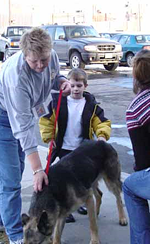 There are many ways that you can take to help the increasing number of homeless and hungry pets in your community. Here are a list of 15 of those ways you can help and you can probably think of others too.
There are many ways that you can take to help the increasing number of homeless and hungry pets in your community. Here are a list of 15 of those ways you can help and you can probably think of others too.
- Make a donation to a local shelter or rescue group’s general fund which can be used for whatever the group chooses.
- Organize a fundraiser – a garage sale, pet charity auction, variety show, etc. whose benefits go to the group of your choice.
- Donate to a specific program already in place at an organization you choose to support. Examples are lost pet programs, subsidized adoption programs, cruelty investigation programs and spay/neuter programs. Your gift then will be used for that particular program and nothing else.
- Enroll in a subscription donation program. You’ve seen them on TV. You pledge to donate a specific amount each month to go toward caring for needy pets. As a caution, it is good to check out the group you are donating to, ensuring your money is going directly toward care and not for administrative costs.
- Make a visit to one of the websites that will donate dog or cat food to shelters and rescue groups when you click on some of their advertiser links. www.FreeKibble.com is one such site. The search engine www.dogpile.com (a search engine that simultaneously searches Google, Bing and Yahoo and displays all results) will donate a percentage of their ad revenue to help homeless pets. This is a painless, no money involved way to help – although it is also a good idea to support those businesses participating in the program by advertising and donating money.
- Memorials are an overlooked way to donate and honor a favorite pet or person who has passed away. You can donate in the name of your loved one and know that they would be proud you’ve done so.
- Tributes are cash donations to honor living people and pets who are making a difference in your life, or in the community. Most groups will send you a note to the honoree telling them of your generosity on their behalf.
- Donations of goods and services the shelter can use – known as in-kind donations. Shelters or rescue groups will often have a “Wish List” of items they need posted on their website, but if you don’t see it, just call and ask. Services can also be donated – printing, copying, cleaning, grooming, vet care and many other services can be donated and this is a great way for small businesses to help.
- Cut coupons out of the paper and send them to a rescue. If possible, use the coupons yourself and deliver the items to the shelter. Pet companies will frequently offer a buy one-get one coupon or a free item especially for new products. If you’re buying something for your pet, use the coupon and give the extra one to the shelter. The coupons don’t have to be for pet food, shelters and rescues need cleaning supplies including laundry detergent, bleach and paper towels.
- Sponsor a homeless animal. Many shelters and rescue groups offer sponsorship opportunities for their hard-to-place animals. You pick the animal you want to sponsor, donate a set amount each month until the animal is adopted, and in exchange you get a photo and periodic updates on the animal.
- If you have a business, become a sponsor for a pet friendly event that benefits a local shelter or rescue group. Sponsorships by small businesses and pet-friendly establishments allow organizations to put on bigger, better fund raising events without challenging already tight budgets, and they’re a good deal for the companies, too. In exchange for a sponsorship most organizations offer free advertising in event promotional materials and programs and signage the evening of the event as well as free admission and other perks.
- Do you have old blankets and towels in your linen closet? Don’t throw them away, take them to a shelter. With so many pets under one roof, laundry is a never ending chore. The pets really appreciate having a soft bed and they don’t care if it’s a Backstreet Boys blanket.
Are you a groomer? If so, donate your time and offer to groom some homeless pets. They will not only look better and feel better but their chances of being adopted will be greater. - Use your special skills- The shelter may need help with computers, book keeping, or building a better shelter. Get creative about the ways which you use your skills to help.
- The shelter can be an extremely stressful atmosphere for a dog or cat, go and keep a furry friend company for a day
- Adopt a homeless pet and take it home with you, making sure you are prepared to keep him or her as your companion for the rest of their life.
It does not matter how you donate. The important thing is that you do what you can to help animals and their caregivers. Each and ever dollar counts in the war against pet homelessness and pet overpopulation.
Thank you what what you ARE doing. Together we can all make a difference.
Linda
A new term that means HORRIBLE, Hoarding Pets
Thursday, September 24th, 2009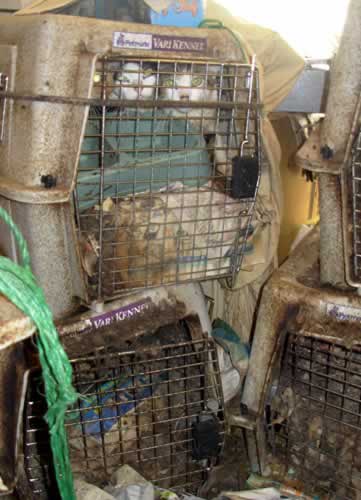
- Ruth Knueven and her 488 cats — 222 of them dead, and most of the others so wild and sick that they had to be euthanized.
- 800 dogs seized from mobile home of elderly couple outside Tucson, Arizona.
- Police in Chester Township, New Jersey found 80 cats and 1 dog in a million-dollar home that was full of animal feces up to 2 feet deep in some parts of the house.
- A man who’d previously faced animal hoarding and cruelty charges was found holed up in a motel room with 21 cats.
And the stories go on and on. When you read about someone who is hoarding animals, think HORRIBLE, for that’s what it usually is. And it’s horrible for everyone involved. The hoarders, the animals, the shelters who now get the pets and the rescuers who have to face the filth, the stench, the dead and dying.
The saddest part is that in the majority of these situations, the people who are found hoarding these animals started doing so out of love of them.
It’s true.
Most animal hoarders start out rescuing their victims, caring for them as best as they can. They feel an obligation to save these poor unfortunate creatures from life in a shelter, abandonment or euthanasia.
All too quickly things spiral out of control for the hoarder and their ability to care for the animals they purport to love.
It’s too much for them, and the pets begin to suffer from lack of medical care, food and love.
But rather than seek help, hoarders typically choose to ignore the bad parts and focus on the ‘good’ they are doing for these poor creatures. Typically they become caught up in the overwhelm of doing what little they can for the animals that when one is sick or dies, they are too overwhelmed to dispose of the body – so these will be stashed somewhere or put in a freezer until they have time to take proper care.
That time never comes and things continue to accumulate.
Now the rescued need rescuing but, due to the nature of animal hoarding, the problem is usually hidden away behind closed doors and no one knows there is a problem until the problem is so far out of hand the authorities have to be called in to resolve it.
In the video below you can see a typical situation:
In this case over 200 cats had to be euthanized, not because of ill health necessarily, but because they’d become feral cats and weren’t able to become socialized enough to be adoptable.
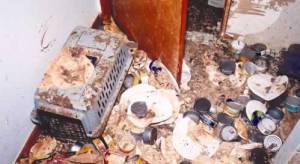
So sad and so unnecessary.
What it is:
The Human Society US defines an animal hoarder as a person who has more animals than he or she can properly care for.
Another defining characteristic is the hoarder’s denial of his inability to care for the animals and his failure to grasp the impact his neglect has on the animals, the household, and the human occupants of the dwelling.
An animal hoarder is someone who:
- Collects large numbers of animals.
- Denies those animals basic care such as adequate food, water, shelter, veterinary care and sanitary conditions in which to live.
What you can do:
If you know of someone who fits the above description, realize that the vast majority of time that person cannot tell that they are not taking proper care of the animals that have. It’s always wise to contact your local chapter of the humane society and report your suspicions and why you think there might be a case of animal hoarding.
If you are someone who has more animals than you can properly care for, you can also seek help from a local adoption agency, Humane Society or shelter. It’s not a crime to do something to take care of the problem yourself.
It is a crime if you do not.
Here are some additional resources for more information on the subject of animal hoarding:
http://en.wikipedia.org/wiki/Animal_hoarding
http://www.animalhoarding.org/


 Many emergency veterinarians enjoy the challenge of saving an injured pet in a gunshot wound case, especially when we have a good outcome.
Many emergency veterinarians enjoy the challenge of saving an injured pet in a gunshot wound case, especially when we have a good outcome.